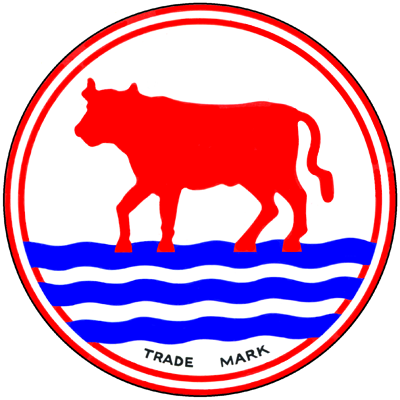
Oxford & Shipton Logo.
Location:
- Grid reference: SP48181735
- x=448180
- y=217350
- 51°51'10"N; 1°18'1"W
- Civil Parish: Shipton on Cherwell, Oxfordshire
Clinker manufacture operational: 1929 - 1987
Approximate total clinker production: 12.5 million tonnes (33rd).
Raw materials:
- Cornbrash Limestone (Cornbrash Formation: ~166 Ma): up to 3 m
- “Forest Marble” clays and limestones (Forest Marble Formation: ~166.5 Ma): 6 m
- Great Oolite Limestone (White Limestone Formation: ~167 Ma): up to 15 m
Ownership:
- 1929-1934 Oxford and Shipton Cement Co. Ltd
- 1934-1949 Alpha Cement Co. Ltd
- 1949-1987 APCM (Blue Circle)
Sometimes known as Shipton on Cherwell Works. Built to replace the Kirtlington plant, 3 km away; the company name was changed at the same time. The quarry is similar to that at Kirtlington, with interbedded clays and limestones that varied considerably laterally, requiring a disciplined blending of various parts of the long face to obtain the correct composition. The raw materials were excellent for dry process, but among British equipment suppliers, this was not an option, and a wet process was adopted. The plant became the first to use slurry de-flocculants systematically, and routinely made slurry with less than 35% moisture content, with a resulting benefit to energy consumption. With the acquisition of the plant by Alpha, two German kilns (by MIAG) were installed, because of Gowan’s enthusiasm for calcinators. With the advent of Northfleet in 1970 and the post oil crisis downturn, the plant was reduced to single kiln operation.
Although on the Oxford canal, it never used this: its transport was primarily by rail, using the Oxford-Banbury line. The last kiln shut down in 1987. The plant continued for a while grinding clinker from Northfleet and Westbury, but closed in 1990.
In its latter years, the plant was kept running to maintain permissions for a prospective large dry process plant, which would have provided the nearest source of efficiently-manufactured cement to the London market. The scheme was abandoned due to a temporary downturn in energy prices and a lack of commitment to cement manufacture from Blue Circle. The area remains the best source of cement raw materials for the London market. Much of the plant is still intact, although there are currently development schemes to clear it and the quarry. As at Kirtlington, parts of the quarry are SSSIs due to the unique geology exposed.
Power Supply
The plant was entirely electrically powered from the outset, using power from Osney, later merged into the grid.
Rawmills
Three 550 kW Edgar Allen ball mills.
Four rotary kilns were installed:
Kiln A1
Supplier: Edgar Allen
Operated: 1/1929-1933
Process: Wet
Location: hot end 448175,217477: cold end 448162,217536: entirely enclosed
Dimensions: 200’0”× 9’0” (metric 60.96×2.743)
Rotation (viewed from firing end): clockwise.
Slope: 1/24 (2.388°)
Speed: 0.55-1.25 rpm
Drive: 60 kW
Kiln profile: 0×2743: 60960×2743: tyres at 2292, 18205, 36208, 54210: turning gear at 33769.
Cooler: rotary 60’0” × 7’0” (metric 18.29×2.134) beneath firing floor
Cooler profile: 0×1918: 152×2134: 18288×2134: tyres at 3658, 14478.
Fuel: Coal
Coal mill: direct: Clarke Chapman turbo pulveriser plus a spare shared with kiln 2.
Exhaust: via ID fan direct to stack.
Typical Output: 170 t/d
Typical Heat Consumption: 7.33 MJ/kg
Kiln A2 (=B2)
Supplier: Edgar Allen
Operated: 1/1929-1987
Process: initially Wet: calcinator added in 1933, removed 1973
Location: hot end 448184,217478: cold end 448171,217538: entirely enclosed
Dimensions: 200’0”× 9’0” (metric 60.96 × 2.743)
Rotation (viewed from firing end): anti-clockwise.
Slope: 1/24 (2.388°)
Speed: 0.55-1.25 rpm
Drive: 60 kW
Kiln profile: 0×2743: 60960×2743: tyres at 2292, 18205, 36208, 54210: turning gear at 33769.
Cooler: rotary 60’0”× 7’0” (metric 18.29×2.134) beneath firing floor
Cooler profile: 0×1918: 152×2134: 18288×2134: tyres at 3658, 14478.
Fuel: Coal
Coal mill: originally direct: Clarke Chapman turbo pulveriser. From 1935, indirect: a 205 kW Tirax ball mill supplied all three kilns: from 1975 direct fired by 112 kW No18 Atritor.
Exhaust: initially via ID fan direct to stack: cyclones and an electrostatic precipitator were added in 1948.
Typical Output: 1929-1933 183 t/d: 1933-1947 257 t/d: 1947-1960 309 t/d: 1960-1973 306 t/d: 1973-1987 297 t/d
Typical Heat Consumption: 1929-1933 7.32 MJ/kg: 1933-1947 6.62 MJ/kg: 1947-1960 6.44 MJ/kg: 1960-1973 5.90 MJ/kg: 1973-1987 5.78 MJ/kg
Kiln B1
Supplier: MIAG
Operated: 1933-7/1/1975
Process: Wet with calcinator
Location: hot end 448192,217480: cold end 448182,217523: entirely enclosed
Dimensions (from cooler ports) : Metric 43.76 × 2.450
Rotation (viewed from firing end): anti-clockwise.
Slope: 1/30 (1.910°)
Speed: 0.56-1.12 rpm
Drive: 60 kW
Kiln profile (from cooler ports): 0×2450: 43760×2450: tyres at 6130, 36170: turning gear at 33770
Cooler: Reflex planetary: metric 9 × 3.68 × 0.946
Fuel: Coal
Coal mill: indirect: a 205 kW Tirax ball mill supplied all three kilns
Exhaust: initially from the calcinator via a cyclone and ID fan direct to stack: an electrostatic precipitator was added in 1948.
Typical Output: 1933-1941 247 t/d: 1942-1953 214 t/d: 1954-1961 246 t/d: 1962-1975 255 t/d
Typical Heat Consumption: 1933-1941 6.79 MJ/kg: 1942-1953 7.06 MJ/kg: 1954-1961 7.23 MJ/kg: 1962-1975 6.37 MJ/kg
Kiln B3
Supplier: MIAG
Operated: 1935-3/1975
Process: Wet with calcinator: calcinator removed in 1973.
Location: hot end 448175,217477: cold end 448162,217536: entirely enclosed
Dimensions (from cooler ports): Metric 60.85 × 3.155
Rotation (viewed from firing end): anti-clockwise.
Slope: 1/20 (2.866°)
Speed: 0.50-1.00 rpm
Drive: 56 kW
Kiln profile (from cooler ports): 0×3155: 60850×3155: tyres at 6458, 27457, 51460: turning gear at 29457
Cooler: Reflex planetary: metric 10 × 4.65 × 1.153
Fuel: Coal
Coal mill: indirect: a 205 kW Tirax ball mill supplied all three kilns
Exhaust: initially from the calcinator via a cyclone and ID fan direct to stack: an electrostatic precipitator was added in 1948.
Typical Output: 1935-1951 303 t/d: 1952-1960 336 t/d: 1961-1973 348 t/d: 1973-1975 333 t/d
Typical Heat Consumption: 1935-1951 6.51 MJ/kg: 1952-1960 6.66 MJ/kg: 1961-1973 6.09 MJ/kg: 1973-1975 6.14 MJ/kg
Sources:
- Primary Sources:
- Greenhithe Archive
- Midland Area archive
- Ordnance Survey 1:2500 mapping
- BGS mapping and monographs
- Confirmatory Sources: